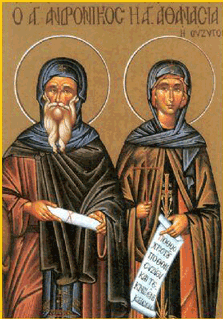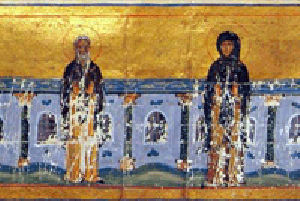

Source
The primary source of their life is contained in the life of Abba Daniel of Sketes, preserved in several languages and manuscript traditions.
Life
Saint Andronicus and his wife Athanasia lived in Antioch in the sixth century. A wealthy couple, they were also and much loved for their piety and devotion to God. St Andronicus was a craftsman, a goldsmith, or in some accounts, a money-changer, who managed his wealth virtuously by dividing all his income into three parts, one part of the poor, another for the church and monks, and keeping the remainder to support his family. His wife, St Athanasia was, similarly was very devout. They had two children, a son John, and a daughter, Mary. After their daughter's birth, they decided to live in continence, and devoted themselves to the service of God though serving the needs the poor. On Sundays, Mondays, Wednesday, and Fridays, Andronicus washed and took care of men, while Athanasia washed and took care of poor women.
One day, Athanasia returned home from her duties, she found John, now 12, and Mary, aged 10, very sick, and immediately comfort them as they were burning with fever. When Andronicus came home and realized what was happening, he began to interceded for them, going to the shrine of St Julian. When he returned he found his house a scene of lamentation, with both children dead.
Try as he might, Andronicus was unable to comfort his profoundly grief wife. So it was Athanasia was that, in her grief, she had a vision of the St. Justin Martyr, explaining to her that they children were in blessed repose, and that she would do well to weep for her own sins, and clothing her in a monk's habit, saying to her:
Just as a person, by nature, demands food and its is impossible for that person not give himself something to eat, so too on that day the little ones will also demand of Christ the good things to come, saying "Righteous Judge, you deprived us of earthly things, do not deprive us also of heavenly things."After handing over their wealth to his father-in-law for the establishment of a hospital and a monastic guesthouse, the saintly spouses set out for Alexandria, taking with them a small amount of blessed bread. As they departed Antioch, Athanasia offered this prayer:
God, who said to Abraham and Sarah
Leave your land and your kindred and go to the land that I will show you, be our guide also in our fear of you. Look! For your name's sake, we have left the doors of our house open; do not close the door to your kingdom on us!Coming near to Alexandria, they visited the shrine of St Menas, where they parted company, with Andronicus going to enter the monastery of Abba Daniel at Scties, and Athanasia one of the women's monasteries at Tabennisi, of which Palladius has written.
After twelve years of ascetic life, St Andronicus went to Jerusalem to pray at the holy places. He met a co-pilgrim, St Athanasia, who, foreseeing the difficulties of the journey, had donned men's attire and assumed the name "Athanasius". She recognized him. However, he, due to the changes in her appearance from ascetical labors, did not recognize her. At her suggestion, they agreed to travel in silence and as if they were alone.
When they returned from Jerusalem, both monks, obtaining the blessing of Abba Daniel, settled into a single cell to live the ascetic life in silence, struggling in the acquisition of virtue for another twelve years.
Abba Daniel would often visit them, instructing them in the way. When she understood that the time of her repose was at hand, "Abba Athanasius" wrote a note to be read after her death and gave instructions about it to Abba Daniel. At the end of this conversation, she received Common and slept. It was only when her body was being prepared for burial that she was found to be women. When the note was found, it further revealed her secret of being Andronicus' wife.
St. Andronicus reposed ten days after St Athanasia.
Understanding Them
St. Nil Sorsky, in his Ustav, speaks of Abba Daniel and his disciples as examples of how to start to live a healthy life in silence and prayer.
In the troparion and kontakion for their feast, the Church points to sublime varied colors of charity, chastity, and marriage.
Underneath these attributes, however, are pious lives transformed by profound suffering into a relationship of authentic companionship, lived out in the purity of silence-keeping, dedicated to God.
The modern ethos of marriage alleges "health" is produced by self-satisfaction, recoiling from asceticism. Yet these modern marriages fail precisely for want of the practice of ascetical virtues, established by vesting intimately familiar relationships with sacred humanity.
What one sees in this beautiful marriage is the humble expression of the unity and balance characteristic of sublime gracefulness.
Troparion and Kontakion
Troparion for Sts. Andronicus and Athanasia, Plagal of the First Tone
Ye adorned your divinely-wrought robe of chastity with the sublime varied colors of sacred virtues in God, when with one accord ye strove in the ascetic life. Wherefore, your silence on the earth was received equally with the thrice-holy hymn in heaven; O wise Andronicus, pray God, with Athanasia, that we all be saved.
Kontakion for Sts. Andronicus and Athanasia, Plagal of the Fourth Tone
Let us, the faithful, crown with laurels of befitting hymns the wise Andronicus, who lived in blameless righteousness, with the godly Athanasia, his spouse in Christ God; who have shown the type of lawful wedlock to the world and became divine examples of monastic life. Let us cry to them: Rejoice, O yoke-mates in holiness.

Their feast is celebrated on Oct 9